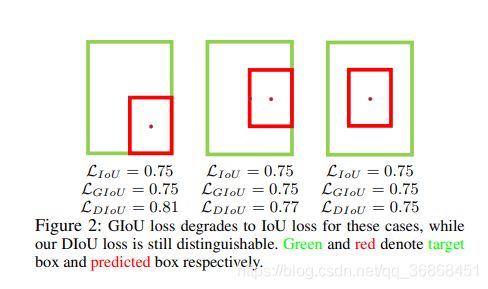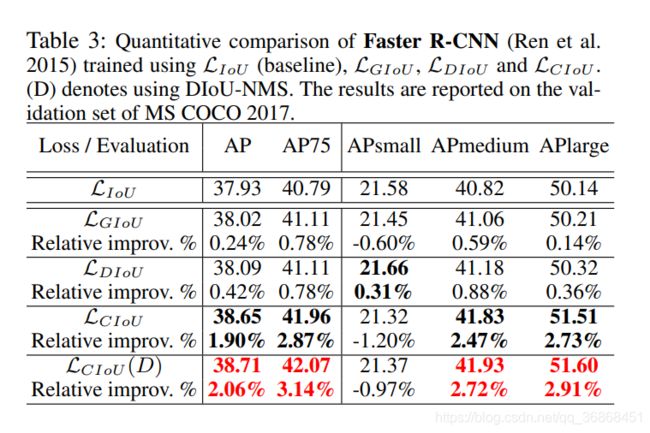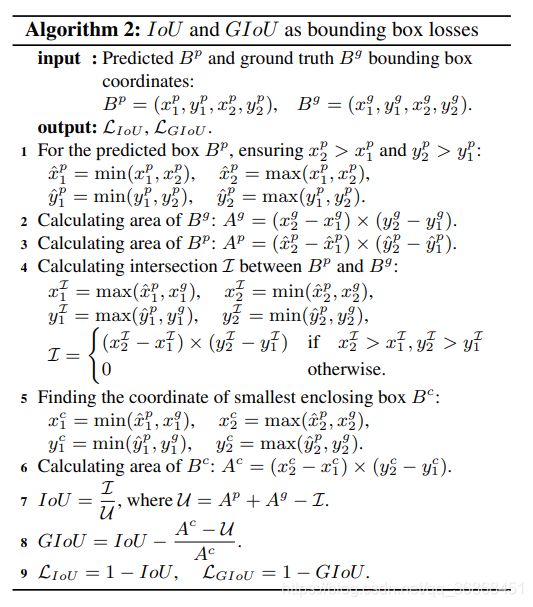论文阅读-目标检测损失函数GIoU,DIoU,CIoU
目标检测损失函数GIoU,DIoU,CIoU
GIoU论文链接
DIoU和CIoU论文链接
1. GIoU
1.1. 问题提出
1.1.1. 范数损失的缺陷
在GIoU之前,主要是以IoU或者 l n n o r m l_n norm lnnorm作为损失函数的,而这些损失函数实际上是不够精细的。也就是说,即使观感上的差距很大,损失的值也会相同。以giou论文里举出的(a)图为例:

此时以 l 2 n o r m l_2norm l2norm作为损失函数(也就是两对点之间的欧氏距离),为了简便起见,固定一个点不动(假设是左下角的点不动),以另一个点为圆心,做一个半径为r的圆,那么此时落在圆上的任意一点与固定点组成的bbox(黑色)和ground truth(绿色)之间的 l 2 n o r m l_2 norm l2norm损失值都是相同的(如a所示),在观感上,我们可能会趋向于最右侧的预测结果,但是在计算机使用 l 2 l_2 l2损失的时候是无法区分的。
1.1.2. IoU损失的缺陷
Iou只在bbox和gt之间有交集的时候才会生效,在他们没有交集的时候IoU始终为0,这样不能为反向传播时提供响应的梯度。例如下面的情况,IoU都为0,此时很难让网络进行调整。

1.2. 解决方案
针对IoU不能适应无交集的问题,提出了最小凸包的方案。
所谓的最小凸集就是恰好包含了gt和bbox的一个矩形,如下图所示,红色就是最小凸集。

而 G I o U = I o U − C − ( A ∪ B ) C GIoU= IoU - \frac {C-(A \cup B)} {C} GIoU=IoU−CC−(A∪B)
在最小凸集的基础上,就解决了在gt与bbox无交集时梯度为0的问题。GIoU实际上就是在最小化这个最小凸集。
1.3 算法与代码
def getConvexShape(bbox_gt,bbox_pd):
return [min(bbox_gt[0],bbox_pd[0]),min(bbox_gt[1],bbox_pd[1]),max(bbox_gt[2],bbox_pd[2]),max(bbox_gt[3],bbox_pd[3])]
def getBboxArea(bbox):
if bbox[2] - bbox[0] > 0 and bbox[3]-bbox[1] > 0:
return (bbox[2]-bbox[0]) * (bbox[3]-bbox[1])
else:
return 0.0
def getIntersection(bbox_gt,bbox_pd):
return [max(bbox_gt[0],bbox_pd[0]),max(bbox_gt[1],bbox_pd[1]),min(bbox_gt[2],bbox_pd[2]),min(bbox_gt[3],bbox_pd[3])]
def getEnclosingBbox(bbox_cvx,bbox_gt):
return [min(bbox_cvx[0],bbox_gt[0]),min(bbox_cvx[1],bbox_gt[1]),max(bbox_cvx[2],bbox_gt[2]),max(bbox_cvx[3],bbox_gt[3])]
def getGIoU(bbox_gt,bbox_pd):
#1. get bbox_hat
bbox_cvx = getConvexShape(bbox_gt,bbox_pd)
#2. caculate the area of ground truth
area_bbox_gt = getBboxArea(bbox_gt)
#3. caculate the area of bbox_hat
area_bbox_cvx = getBboxArea(bbox_cvx)
area_bbox_pd = getBboxArea(bbox_pd)
#4. caculate the area of Intersection
bbox_inter = getIntersection(bbox_gt,bbox_pd)
area_bbox_inter = getBboxArea(bbox_inter)
#5. Finding the coordinate of smallest enclosing box
bbox_enclose = getEnclosingBbox(bbox_cvx,bbox_gt)
#6. caculate the area of bbox_enclose
area_bbox_enclose = getBboxArea(bbox_enclose)
#7. caculate IoU
#area_u = area_bbox_gt + area_bbox_cvx - area_bbox_inter # in paper
#IoU = area_bbox_inter / area_u # in paper
IoU = area_bbox_inter / ( area_bbox_gt + area_bbox_pd - area_bbox_inter )
#8. caculate GIoU
#GIoU = IoU - (( area_bbox_enclose - area_u ) / area_bbox_enclose) # in paper
GIoU = IoU - ( ( area_bbox_cvx - area_bbox_gt - area_bbox_pd + area_bbox_inter ) / area_bbox_cvx )
return IoU,GIoU
我不需要用到Loss,所以只是简单返回IoU,但是复现为原版的算法时出现了一些问题,以如下的bbox为例
bbox_gt = [5,5,10,10]
bbox_pd_1 = [0,0,3,3]
bbox_pd_2 = [0,0,1,1]

这似乎并不符合GIoU论文里的表述,这两者应当是不同的。在修正为现在的代码后解决了这样的问题。(不知道是我理解有问题还是算法有问题)
2. DIoU
2.1 问题提出
首先DIoU的作者观察到了GIoU收敛很慢以及GIoU本身也存在的一些问题。

首先是收敛很慢的问题,如上图第一行所示,在迭代了400次之后的bbox依然距离gt有很大的差距。其次是GIoU在bbox是gt或者gt是bbox的时候会退化到IoU作为损失函数,此时在内部存在了相同的不能为模型提供梯度的问题(这里不是梯度为0,而是梯度相同,无法区分)。最后GIoU的收敛过程倾向于先让bbox变大,然后再进行IoU的迭代。

如上所示,显然第三个是我们观感上比较倾向的选择,但是计算机在使用IoU或者GIoU时是无法区分的。
2.2. 问题解决
那么针对这种问题,作者提出了将中心点作为考量的依据之一,并且总结出了一条好的损失函数应该考量的特性。

原作者提出了加入如下的惩罚项可以更快的收敛
R D I o U = ρ 2 ( b , b g t ) c 2 \bm R_{DIoU} = \frac {\rho^2( \bm {b}, \bm {b^{gt}})}{c^2} RDIoU=c2ρ2(b,bgt)
其中 ρ 2 ( b , b g t ) {\rho^2( \bm {b}, \bm {b^{gt}})} ρ2(b,bgt)指的是bbox与gt中心点之间的距离,而c指的是最小凸集对角线的长度。
最终提出的DIoU损失函数如下:
L D I o U = 1 − I o U + R D I o U L_{DIoU}= 1 - IoU + R_{DIoU} LDIoU=1−IoU+RDIoU
在此基础上作者对这些损失函数进行了模拟实验的可视化,结果如下

2.3. 代码实现
仿照GIoU的算法,很容易就可以实现DIoU,最终代码如下(有部分函数用到了上面GIoU的函数):
import math
def getCenterPoint(bbox):
return (bbox[2]+bbox[0]) / 2. , (bbox[3]+bbox[1]) / 2.
def getDistance(point1,point2):
return math.sqrt((point1[0]-point2[0]) ** 2 + (point1[1]-point2[1]) ** 2)
def getDIoU(bbox_gt,bbox_pd):
#1. get bbox_hat
bbox_cvx = getConvexShape(bbox_gt,bbox_pd)
#2. caculate the area of ground truth
area_bbox_gt = getBboxArea(bbox_gt)
#3. caculate the area of predictions
area_bbox_pd = getBboxArea(bbox_pd)
#4. caculate the area of Intersection
bbox_inter = getIntersection(bbox_gt,bbox_pd)
area_bbox_inter = getBboxArea(bbox_inter)
#5. caculate the center points
center_point_gt = getCenterPoint(bbox_gt)
center_point_pd = getCenterPoint(bbox_pd)
#6. caculate the distance between the center point gt and the center point pd
rho_2 = getDistance(center_point_gt, center_point_pd) ** 2
#7. caculate the diag distance of cvx shape
c_2 = getDistance(bbox_cvx[0:2], bbox_cvx[2:4]) ** 2
#8. caculate IoU
IoU = area_bbox_inter / ( area_bbox_gt + area_bbox_pd - area_bbox_inter )
#9. get DIoU
DIoU = IoU - rho_2 / c_2
return IoU, DIoU
3. CIoU
在DIoU的基础上,为了让模型更快更好的收敛,原作者总结了三个目标检测损失函数应该考虑的因素,分别是overlap area, central point distance and aspect ratio。
基于此,作者提出了CIoU,也就是在DIoU的基础上增加了一个新的形状比例的惩罚项,如下:
R C I o U = α v R_{CIoU}= \alpha v RCIoU=αv
其中 α = v ( 1 − I o U ) + v \alpha = \frac{v}{(1-IoU)+v} α=(1−IoU)+vv
v = 4 π 2 ( a r c t a n w g t h g t − a r c t a n w h ) 2 v=\frac{4}{\pi^2}(arctan\frac{w^{gt}}{h^{gt}}-arctan\frac{w}{h})^2 v=π24(arctanhgtwgt−arctanhw)2
最终使用这些损失函数在不同的模型进行了比较,详情可以参考论文。

3.1. 代码实现
仿照上面的方法,实现CIoU的代码如下(需要注意bbox的表示类型,应该是[x1,y1,x2,y2],而不是[x,y,w,h]):
def getWidthAndHeight(bbox):
return bbox[2]-bbox[0],bbox[3]-bbox[1]
def getCIoU(bbox_gt,bbox_pd):
#1. get bbox_hat
bbox_cvx = getConvexShape(bbox_gt,bbox_pd)
#2. caculate the area of ground truth
area_bbox_gt = getBboxArea(bbox_gt)
#3. caculate the area of predictions
area_bbox_pd = getBboxArea(bbox_pd)
#4. caculate the area of Intersection
bbox_inter = getIntersection(bbox_gt,bbox_pd)
area_bbox_inter = getBboxArea(bbox_inter)
#5. caculate the center points
center_point_gt = getCenterPoint(bbox_gt)
center_point_pd = getCenterPoint(bbox_pd)
#6. caculate the distance between the center point gt and the center point pd
rho_2 = getDistance(center_point_gt, center_point_pd) ** 2
#7. caculate the diag distance of cvx shape
c_2 = getDistance(bbox_cvx[0:2], bbox_cvx[2:4]) ** 2
#8. caculate IoU
IoU = area_bbox_inter / ( area_bbox_gt + area_bbox_pd - area_bbox_inter )
#9. caculate the width and height of the bboxes
w_gt,h_gt = getWidthAndHeight(bbox_gt)
w_pd,h_pd = getWidthAndHeight(bbox_pd)
#10. caculate the aspect ratio in cIoU
ciou_v = 4/(math.pi ** 2) * (math.atan(w_gt/h_gt) - math.atan(w_pd/h_pd)) ** 2
#11. caculate the alpha in cIoU
ciou_alpha = ciou_v / (1 - IoU + ciou_v)
#12. caculate the ciou
CIoU = IoU - rho_2 / c_2 - ciou_alpha * ciou_v
return IoU,CIoU
4. 后记
4.1. 不理解的问题
CIoU为什么惩罚项要写成那个样子原作者并没有解释
4.2. 自己的想法
CIoU原作者提出的三点因素虽说都有影响,但是并没有针对这些因素进行定量的研究,比如这些因素中究竟哪一个的影响最大?
